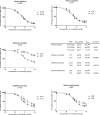Convergent Balancing Selection on the Mu-Opioid Receptor in Primates
- PMID: 28333316
- PMCID: PMC6279279
- DOI: 10.1093/molbev/msx105
Convergent Balancing Selection on the Mu-Opioid Receptor in Primates
Abstract
The mu opioid receptor is involved in many natural processes including stress response, pleasure, and pain. Mutations in the gene also have been associated with opiate and alcohol addictions as well as with responsivity to medication targeting these disorders. Two common and mutually exclusive polymorphisms have been identified in humans, A118G (N40D), found commonly in non-African populations, and C17T (V6A), found almost exclusively in African populations. Although A118G has been studied extensively for associations and in functional assays, C17T is much less well understood. In addition to a parallel polymorphism previously identified in rhesus macaques (Macaca mulatta), C77G (P26R), resequencing in additional non-human primate species identifies further common variation: C140T (P47L) in cynomolgus macaques (Macaca fascicularis), G55C (D19H) in vervet monkeys (Chlorocebus aethiops sabeus), A111T (L37F) in marmosets (Callithrix jacchus), and C55T (P19S) in squirrel monkeys (Saimiri boliviensis peruviensis). Functional effects on downstream signaling are observed for each of these variants following treatment with the endogenous agonist β-endorphin and the exogenous agonists morphine, DAMGO ([d-Ala2, N-Me-Phe4, Gly5-ol]-enkephalin), and fentanyl. In addition to demonstrating the importance of functional equivalency in reference to population variation for minority health, this also shows how common evolutionary pressures have produced similar phenotypes across species, suggesting a shared response to environmental needs and perhaps elucidating the mechanism by which these organism-environment interactions are mediated physiologically and molecularly. These studies set the stage for future investigations of shared functional polymorphisms across species as a new genetic tool for translational research.
Keywords: balancing selection; molecular evolution; opioid; primates.
© The Author 2017. Published by Oxford University Press on behalf of the Society for Molecular Biology and Evolution. All rights reserved. For permissions, please e-mail: journals.permissions@oup.com.
Figures






Similar articles
-
A mu-opioid receptor single nucleotide polymorphism in rhesus monkey: association with stress response and aggression.Mol Psychiatry. 2004 Jan;9(1):99-108. doi: 10.1038/sj.mp.4001378. Mol Psychiatry. 2004. PMID: 14699447
-
Human expression variation in the mu-opioid receptor is paralleled in rhesus macaque.Behav Genet. 2008 Jul;38(4):390-5. doi: 10.1007/s10519-008-9207-2. Epub 2008 Apr 1. Behav Genet. 2008. PMID: 18379868
-
Effect of the A118G polymorphism on binding affinity, potency and agonist-mediated endocytosis, desensitization, and resensitization of the human mu-opioid receptor.J Neurochem. 2004 May;89(3):553-60. doi: 10.1111/j.1471-4159.2004.02340.x. J Neurochem. 2004. PMID: 15086512
-
Genetic polymorphisms of drug-metabolizing cytochrome P450 enzymes in cynomolgus and rhesus monkeys and common marmosets in preclinical studies for humans.Biochem Pharmacol. 2018 Jul;153:184-195. doi: 10.1016/j.bcp.2017.12.015. Epub 2017 Dec 23. Biochem Pharmacol. 2018. PMID: 29277691 Review.
-
Research Relevant Conditions and Pathology in Nonhuman Primates.ILAR J. 2020 Dec 31;61(2-3):139-166. doi: 10.1093/ilar/ilab017. ILAR J. 2020. PMID: 34129672 Free PMC article. Review.
Cited by
-
Tapentadol shows lower intrinsic efficacy at µ receptor than morphine and oxycodone.Pharmacol Res Perspect. 2022 Feb;10(1):e00921. doi: 10.1002/prp2.921. Pharmacol Res Perspect. 2022. PMID: 35084120 Free PMC article.
-
From Pharmacology to Physiology: Endocrine Functions of μ-Opioid Receptor Networks.Trends Endocrinol Metab. 2021 May;32(5):306-319. doi: 10.1016/j.tem.2021.02.004. Epub 2021 Mar 3. Trends Endocrinol Metab. 2021. PMID: 33676828 Free PMC article. Review.
-
In Vitro Effects of Ligand Bias on Primate Mu Opioid Receptor Downstream Signaling.Int J Mol Sci. 2020 Jun 3;21(11):3999. doi: 10.3390/ijms21113999. Int J Mol Sci. 2020. PMID: 32503269 Free PMC article.
-
Fine-Scale Characterization of Genomic Structural Variation in the Human Genome Reveals Adaptive and Biomedically Relevant Hotspots.Genome Biol Evol. 2019 Apr 1;11(4):1136-1151. doi: 10.1093/gbe/evz058. Genome Biol Evol. 2019. PMID: 30887040 Free PMC article.
-
Common marmoset (Callithrix jacchus) personality, subjective well-being, hair cortisol level and AVPR1a, OPRM1, and DAT genotypes.Sci Rep. 2018 Jul 6;8(1):10255. doi: 10.1038/s41598-018-28112-7. Sci Rep. 2018. PMID: 29980755 Free PMC article.
References
-
- Arias A, Feinn R, Kranzler HR.. 2006. Association of an Asn40Asp (A118G) polymorphism in the mu-opioid receptor gene with substance dependence: a meta-analysis. Drug Alcohol Depend 83:262–268. - PubMed
-
- Barish PA, Xu Y, Li J, Sun J, Jarajapu YP, Ogle WO.. 2013. Design and functional evaluation of an optically active mu-opioid receptor. Eur J Pharmacol 705:42–48. - PubMed
-
- Barr CS, Schwandt M, Lindell SG, Chen SA, Goldman D, Suomi SJ, Higley JD, Heilig M.. 2007. Association of a functional polymorphism in the mu-opioid receptor gene with alcohol response and consumption in male rhesus macaques. Arch Gen Psychiatry 64:369–376. - PubMed
Publication types
MeSH terms
Substances
Grants and funding
LinkOut - more resources
Full Text Sources
Other Literature Sources
Research Materials

